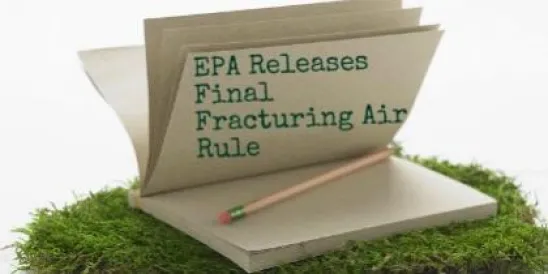The U.S. Environmental Protection Agency (EPA) released final regulations on April 17 to reduce certain emissions at hydraulically fractured wells by 95 percent. The rule, a product of a February 2010 consent decree with WildEarth Guardians and the San Juan Citizens Alliance, adds New Source Performance Standards (NSPS) and amends existing National Emissions Standards for Hazardous Air Pollutants (NESHAPS) for the oil and gas industry.
NSPS Standards
The NSPS standards will reduce by 95 percent volatile organic compound (VOC) emissions during the completion phase of hydraulically fracturing a well. In addition, although not a regulated substance under NSPS, the new rules have the effect of reducing fugitive methane emissions by 25 percent. These VOC and methane emissions reductions will be attained by requiring that all newly fractured or refractured wells incorporate reduced emissions controls (RECs). In total, EPA estimates that the rule will result in reductions of 11,000 tons of Hazardous Air Pollutants (HAPs), 190,000 tons of VOCs, and 1 million tons of methane, with a net benefit of $15 million as a result of the increased profit from captured methane sales.
The final rule adopts several changes suggested during the public comment period, most important of which is the delayed deadline of January 1, 2015 for requiring the use of RECs. While REC technology currently exists, EPA recognized that the number of REC units required to meet the new regulations far exceeds those actually in existence today. Until then, well operators or owners can achieve specified VOC reductions using flaring or other approved combustion methods.
The final rule also modifies the definition of "well completions," limiting the REC requirement to that period when fracing operations end and flowback begins. The requirement remains in effect until the well is either continuously flowing to the flow line or storage vessel for collection (in which case there should be no fugitive emissions) or shut in, whichever occurs first.
In addition, EPA has exempted low-pressure wells from the REC requirement in response to comments that it is unfeasible to require RECs for low-pressure wells. For low-pressure wells, as well as wildcat (or exploratory) and delineation wells, which are also exempted from the REC requirement, operators can continue to use flaring to achieve specified reductions.
EPA also has rewarded early adopters of REC technology, and encourages others to join early, by redefining actions that constitute "modifications" triggering NSPS requirements. Some states require that any source subject to federal NSPS must get a state minor source air permit. This new definition allows owners and operators of existing wells employing RECs to refracture without changing state permit status, thus avoiding delays and costs associated with the state permitting process.
Finally, but importantly, the rest of EPA's new rules are not delayed, and take effect 60 days from publication in the Federal Register.
NESHAPS Standards
While EPA adopted many of the comments about the NSPS rules, stakeholders were less successful in obtaining changes to the proposed NESHAPS standards. In fact, EPA's final NESHAPS amendment is in some ways more strict that the rule proposed several months ago. For example, the proposed rule revised the NESHAPS standard for glycol dehydration unit process vents and leak detection and repair requirements. The final rule also pulls in previously-unregulated "small" glycol dehydrators. Some gas wells using these "small" units to remove water from gas may now be subject to Maximum Available Control Technology (MACT) regulating BTEX emissions, the strictest emission controls available under the Clean Air Act.
EPA estimates that the final NESHAPS amendment will cost industry $3.5 million to implement and will remove 670 tons of HAPs, 1,200 tons of VOCs, and 420 tons of methane.




 />i
/>i

